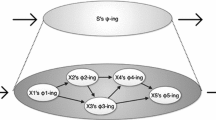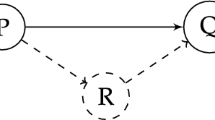Abstract
The experimental interventions that provide evidence of causal relations are notably similar to those that provide evidence of constitutive relevance relations. In the first two sections, I show that this similarity creates a tension: there is an inconsistent triad between (1) Woodward’s popular interventionist theory of causation, (2) Craver’s mutual manipulability account of constitutive relevance in mechanisms, and a variety of arguments for (3) the incoherence of inter-level causation. I argue for an interpretation of the views in which the tension is merely apparent. I propose to explain inter-level relations without inter-level causation by appealing to the notion of fat-handed interventions, and an argument against inter-level causation which dissolves the problem.






Similar content being viewed by others
Notes
Given that all direct causes are contributing causes, I write the conclusion in terms of the latter.
Thanks to an anonymous reviewer for Synthese for pushing me to clarify this section.
References
Baumgartner, M. (2009). Interventionist causal exclusion and non-reductive physicalism. International Studies in the Philosophy of Science, 23(2), 161–178.
Bechtel, W. (2011). Mechanism and biological explanation. Philosophy of Science, 78(4), 533–557.
Bruce, V., & Young, A. (1986). Understanding face recognition. British Journal of Psychology, 77(Pt 3), 305–327.
Couch, M. B. (2011). Mechanisms and constitutive relevance. Synthese, 183(3), 375–388.
Craver, C. F. (2007). Explaining the brain: Mechanisms and the mosaic unity of neuroscience. Oxford: Clarendon Press.
Craver, C. F., & Bechtel, W. (2007). Top-down causation without top-down causes. Biology and Philosophy, 22(4), 547–563.
Damasio, A. R., Damasio, H., & Van Hoesen, G. W. (1982). Prosopagnosia. Neurology, 32(4), 331.
Eberhardt, F., & Scheines, R. (2007). Interventions and causal inference. Philosophy of Science, 74(5), 981–995.
Fagan, M. B. (2012). The joint account of mechanistic explanation. Philosophy of Science, 79(4), 448–472.
Franklin-Hall, L. R. (2014). High-Level Explanation and the Interventionist’s ‘Variables Problem’. British Journal for the Philosophy of Science.
Glennan, S. (1996). Mechanisms and the nature of causation. Erkenntnis, 44(1), 49–71.
Glennan, S. (2009). Mechanisms. In H. Beebee, C. Hitchcock, & P. Menzies (Eds.), The Oxford handbook of causation (pp. 313–325). New York: Oxford University Press.
Harinen, T. (2014). Mutual Manipulability and Causal Inbetweenness. Synthese, 1–20.
Haugeland, J. (1998). Having thought: essays in the metaphysics of mind. Cambridge, MA: Harvard University Press.
Heil, J. (2003). From an ontological point of view. Oxford: Oxford University Press.
Ishai, A., Schmidt, C. F., & Boesiger, P. (2005). Face perception is mediated by a distributed cortical network. Brain Research Bulletin, 67(1–2), 87–93.
Kim, J. (1989). Mechanism, purpose, and explanatory exclusion. Philosophical Perspectives, 3, 77–108.
Kim, J. (1999). Making sense of emergence. Philosophical Studies, 95(1–2), 3–36.
Leuridan, B. (2012). Three problems for the mutual manipulability account of constitutive relevance in mechanisms. British Journal for the Philosophy of Science, 63(2), 399–427.
Levy, A. (2013). Three kinds of new mechanism. Biology and Philosophy, 28(1), 99–114.
Machamer, P. K., Darden, L., & Craver, C. F. (2000). Thinking about mechanisms. Philosophy Of Science, 67(1), 1–25.
Meng, M., Cherian, T., Singal, G., & Sinha, P. (2012). Lateralization of face processing in the human brain. Proceedings of the Royal Society B: Biological Sciences., 279(1735), 2052–2061.
Pearl, J. (2000). Causality: Models, reasoning, and inference. Cambridge: Cambridge University Press.
Raatikainen, P. (2010). Causation, exclusion, and the special sciences. Erkenntnis, 73(3), 349–363.
Schaffer, J. (2012). Grounding, transitivity, and contrastivity. In F. Correia & B. Schnieder (Eds.), Grounding and explanation (pp. 128–138). Cambridge: Cambridge University Press.
Semmelweis, I. (1983). The etiology, concept, and prophylaxis of childbed fever. (K. C. Carter, Trans.). Madison, WI: University of Wisconsin Press.
Sperry, R. W. (1980). Mind–brain interaction: Mentalism yes, dualism no. Neuroscience, 5(2), 195–206.
Tsao, D. Y., Freiwald, W. A., Tootell, R. B., & Livingstone, M. S. (2006). A cortical region consisting entirely of face-selective cells. Science, 311(5761), 670–674.
Waskan, J. (2011). Mechanistic explanation at the limit. Synthese, 183(3), 389–408.
Woodward, J. (2003). Making things happen: A theory of causal explanations. Oxford: Oxford University Press.
Woodward, J. (2004). Counterfactuals and causal explanation. International Studies in the Philosophy of Science, 18(1), 41–72.
Woodward, J. (2008a). Invariance, modularity, and all that. In S. Hartman, C. Hoefer, & L. Bovens (Eds.), Nancy Cartwright’s philosophy of science (pp. 198–237). New York: Taylor & Francis.
Woodward, J. (2008b). Mental causation and neural mechanisms. In J. Howhy & J. Kallestrup (Eds.), Being reduced: New essays on reduction, explanation, and causation. Oxford: Oxford University Press.
Woodward, J. (2011). Mechanisms revisited. Synthese, 183(3), 409–427.
Woodward, J. (2014). Interventionism and causal exclusion. Philosophy and Phenomenological Research, 58(1), 1–45.
Acknowledgments
I wish to thank Carl Craver, John Heil, Frederick Eberhardt, Lena Kästner, Lauren Olin, Isaac Wiegman, Mark Povich, and two anonymous reviewers for Synthese for comments on previous drafts. I also received helpful comments when this paper was presented at the 2012 Models and Mechanisms Conference, Tilburg University; and the 2013 St. Louis Area Philosophy of Science Association Meeting, University of Missouri in St.Louis.
Author information
Authors and Affiliations
Corresponding author
Rights and permissions
About this article
Cite this article
Romero, F. Why there isn’t inter-level causation in mechanisms. Synthese 192, 3731–3755 (2015). https://doi.org/10.1007/s11229-015-0718-0
Received:
Accepted:
Published:
Issue Date:
DOI: https://doi.org/10.1007/s11229-015-0718-0




